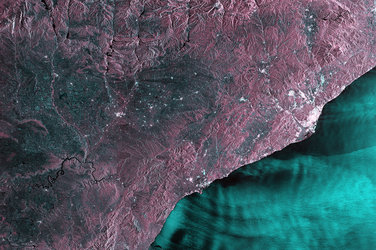Accept all cookies Accept only essential cookies See our Cookie Notice

About ESA
The European Space Agency (ESA) is Europe’s gateway to space. Its mission is to shape the development of Europe’s space capability and ensure that investment in space continues to deliver benefits to the citizens of Europe and the world.
Highlights
ESA - United space in Europe
This is ESA ESA facts Member States & Cooperating States Funding Director General Top management For Member State Delegations European vision European Space Policy ESA & EU Space Councils Responsibility & Sustainability Annual Report Calendar of meetings Corporate newsEstablishments & sites
ESA Headquarters ESA ESTEC ESA ESOC ESA ESRIN ESA EAC ESA ESAC Europe's Spaceport ESA ESEC ESA ECSAT Brussels Office Washington OfficeWorking with ESA
Business with ESA ESA Commercialisation Gateway Law at ESA Careers Cyber resilience at ESA IT at ESA Newsroom Partnerships Merchandising Licence Education Open Space Innovation Platform Integrity and Reporting Administrative Tribunal Health and SafetyMore about ESA
History ESA Historical Archives Exhibitions Publications Art & Culture ESA Merchandise Kids Diversity ESA Brand Centre ESA ChampionsLatest
Space in Member States
Find out more about space activities in our 23 Member States, and understand how ESA works together with their national agencies, institutions and organisations.
Science & Exploration
Exploring our Solar System and unlocking the secrets of the Universe
Go to topicAstronauts
Missions
Juice Euclid Webb Solar Orbiter BepiColombo Gaia ExoMars Cheops Exoplanet missions More missionsActivities
International Space Station Orion service module Gateway Concordia Caves & Pangaea BenefitsLatest
Space Safety
Protecting life and infrastructure on Earth and in orbit
Go to topicAsteroids
Asteroids and Planetary Defence Asteroid danger explained Flyeye telescope: asteroid detection Hera mission: asteroid deflection Near-Earth Object Coordination CentreSpace junk
About space debris Space debris by the numbers Space Environment Report In space refuelling, refurbishing and removingSafety from space
Clean Space ecodesign Zero Debris Technologies Space for Earth Supporting Sustainable DevelopmentLatest
Applications
Using space to benefit citizens and meet future challenges on Earth
Go to topicObserving the Earth
Observing the Earth Future EO Copernicus Meteorology Space for our climate Satellite missionsCommercialisation
ESA Commercialisation Gateway Open Space Innovation Platform Business Incubation ESA Space SolutionsLatest
Enabling & Support
Making space accessible and developing the technologies for the future
Go to topicBuilding missions
Space Engineering and Technology Test centre Laboratories Concurrent Design Facility Preparing for the future Shaping the Future Discovery and Preparation Advanced Concepts TeamSpace transportation
Space Transportation Ariane Vega Space Rider Future space transportation Boost! Europe's Spaceport Launches from Europe's Spaceport from 2012Latest

Zaragoza, Spain
Thank you for liking
You have already liked this page, you can only like it once!
This Copernicus Sentinel-2B image features the city of Zaragoza nestling in the Ebro valley and flanked by mountains to the south.
Zaragoza is the capital of the province of Zaragoza in the region of Aragon in northeast Spain. It is home to about half of Aragon’s population, making it the fifth largest municipality in Spain.
In the top-right of the image, the Ebro River can be seen winding its way through the city. Between its source in the Cantabrian Mountains in the northwest and its delta on the Mediterranean coast, the Ebro River is fed by more than 200 tributaries as it flows across much of northern Spain. In fact, the Ebro River discharges more water into the sea than any other river in Spain.
In an otherwise arid region, the river is used to irrigate crops in the valley – fields can be seen in the top-right of the image.
To the south of the city and dominating the image, lie mountains, relatively devoid of vegetation. There are also mountains to the north that are beyond the frame of this image. These mountains, which effectively surround Zaragoza, form a barrier to moisture from the Atlantic Ocean and from the Mediterranean Sea, creating a semi-arid climate.
On average, Zaragoza only has about 350 mm of precipitation a year, compared to Paris in France, for example, which has around 650 mm of precipitation a year. In recent years, efforts – from discounts on water-saving products to new watering systems for parks – have been in helping to reduce water consumption. Efforts such as these resulted in Zaragoza’s per capita use of water dropping from 150 litres a day in 1997 to just 99 litres a day by 2012.
This image, captured on 25 February 2018, is also featured on the Earth from Space video programme.
-
CREDIT
contains modified Copernicus Sentinel data (2018), processed by ESA -
LICENCE
CC BY-SA 3.0 IGO or ESA Standard Licence
(content can be used under either licence)














 Germany
Germany
 Austria
Austria
 Belgium
Belgium
 Denmark
Denmark
 Spain
Spain
 Estonia
Estonia
 Finland
Finland
 France
France
 Greece
Greece
 Hungary
Hungary
 Ireland
Ireland
 Italy
Italy
 Luxembourg
Luxembourg
 Norway
Norway
 The Netherlands
The Netherlands
 Poland
Poland
 Portugal
Portugal
 Czechia
Czechia
 Romania
Romania
 United Kingdom
United Kingdom
 Slovenia
Slovenia
 Sweden
Sweden
 Switzerland
Switzerland


























